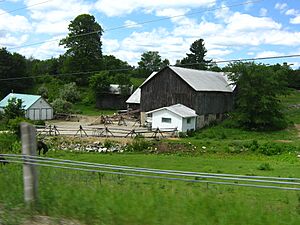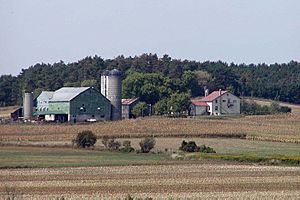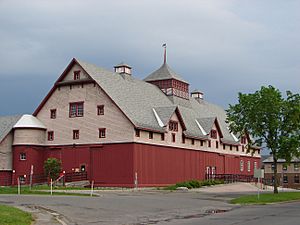History of agriculture in Canada facts for kids
Imagine a time when people grew their own food right where they lived! The history of farming in Canada is a long and interesting story, starting with Indigenous peoples and continuing with European settlers. It shows how people learned to use the land to feed themselves and build communities. From ancient crops like corn and squash to huge wheat fields, agriculture has always been a key part of Canada's growth.
Long ago, in the 16th century, explorers like Samuel de Champlain and Gabriel Sagard saw that the Iroquois and Huron peoples were already expert farmers. They grew important crops like maize (which we call corn), beans, squash, and even sunflowers across North America. Evidence shows that squash was grown in the northeastern woodlands as early as 2300 BC. By 500 AD, corn farming was happening in southern Ontario.
European settlers arrived in Eastern Canada first, long before the West. Later, trading posts and more people came to places like Rupert's Land and the Northwest Territories. These early newcomers combined their European farming methods with the amazing knowledge Indigenous peoples had about the land and animals.
As early as 1605, French settlers called Acadians built special walls called dikes in the Maritimes. This helped them farm marshy land for wheat, flax, vegetables, and pasturage for animals. Today, New Brunswick, Nova Scotia, and Prince Edward Island are known for their dairy farms, livestock, and mixed farming (growing crops and raising animals). Some areas, especially along Nova Scotia's coast, also grow a small amount of fruit.
The American Revolution (1775–1783) caused food shortages. This led to people clearing about 3,100 hectares of land for farming in Newfoundland. In the early 1800s, Irish immigrants also started farming there. However, only a small part of Newfoundland and Labrador is good for growing crops or gardens. Much of the land is covered in forests or tundra (a cold, treeless area). The province does have some dairy farms. After World War II, the government even offered training and bonuses to help farmers. But the biggest "agricultural" contribution from Newfoundland is actually fish processing for food. They mainly catch cod, but also herring, haddock, lobster, rose fish, seals, and whales. This fishing industry relies a lot on exports and the global market.
Contents
Farming in the West and North
Farming in Western Canada began with Peter Pond's gardens at Lake Athabasca in 1778. Even though large-scale farming was still far off, traders from the Hudson's Bay Company, gold rush miners, and missionaries all grew crops, gardens, and raised animals.
The Northwest Territories, Yukon, and Nunavut are mostly covered by the Canadian Shield, which has lots of rocky areas and sub-Arctic forests. This region has a smaller population and isn't used much for commercial farming. Instead, food production here comes from things like whaling, prawns, and trapping.
Farming in Quebec
In New France, new crops like hops and hemp were brought in by 1663, along with livestock. Quebec adopted a special farming system called the seigneurial system. Today, Quebec's farms are famous for their fruits and vegetables. In 1890, a competition called the Agricultural Merit Order began to encourage farmers to improve their farms. Later, around 1930, county farm contests helped over 5,000 farms get better over five years. Quebec also has livestock, mixed farming, and dairy industries. Since 1947, an artificial insemination and breeding centre in Saint-Hyacinthe, Quebec has helped animal breeders.
Indigenous Farming
In the 1800s, Canadian officials thought farming could help Indigenous peoples on the prairies fit into European ways of life. Some Indigenous nations also saw farming as a way to adapt to big changes, like the shrinking numbers of bison. Because of this, promises about farming were often part of Treaty negotiations. However, some Canadian rules, like the Peasant Farm Policy, actually made it harder for First Nations to farm successfully on their reserves. Historian Sarah Carter says these rules were partly designed to stop reserve farms from competing too much with other farms.
Wheat: Canada's Golden Crop
The British had rules called the Corn Laws (1794–1846) that protected their own farmers from wheat imported from British North America. Later, the Canadian–American Reciprocity Treaty in 1854 created a trade agreement between Canada and the United States. This agreement affected how wheat grown in Ontario was traded.
Northern Ontario is mostly tundra and forest. But southern Ontario has good land for livestock, general farming, pastures, and dairy farms. You can also find fruit farms there. Ontario grows the most mixed grains, soybeans, and shelled corn in Canada. It's also where almost all of Canada's tobacco farms are, especially in the Ontario tobacco belt. In 2011, there were 137 tobacco farms in Ontario, three in Quebec, and one on Prince Edward Island.
Lord Selkirk, who started the Red River Colony, harvested the first wheat crop in the western prairies in 1814. A special type of wheat called Red Fife wheat was brought in by 1868. Swine (pigs) arrived in the Red River colony as early as 1819. In the 1800s, the frontier lands of southwest Alberta and southeast Saskatchewan became open for ranching.
Manitoba has a mix of grain farming, livestock, and mixed farming in its southern areas. Cattle ranching near Lake Manitoba is also very successful. Northern Manitoba has many lakes and forests.
The Dominion Lands Act of 1872 gave farming pioneers a chance to get land in western Canada. For a $10 fee, they could "prove up" a quarter section of land (about 65 hectares). They had to live on the land and improve it for three years.
Saskatchewan still has cattle ranching in its southwest. But grain farming and crops like wheat, oats, flax, alfalfa, and rapeseed (especially canola) are very important in the parkland area. Mixed grain farming, dairy farms, and livestock grazing lands are common in the central lowlands of this prairie province.
Alberta is famous for its stampedes, and cattle ranching is a major industry there. Farming also includes livestock, mixed farming, and wheat crops. Alberta is the second-largest producer of wheat in Canada. Grain and dairy farming are also important for Alberta's farmers.
The open parkland area stretches across Manitoba, Saskatchewan, and Alberta. Most of Canada's wheat, oats, flaxseed, and barley come from this region. Meat processing is the biggest industry here, followed by dairy production, breweries, and companies that make farm equipment.
Between 1896 and 1920, Canada had a huge "wheat boom." Rising prices, new railways, and more settlers on the prairies helped this happen, along with new farming technology. By 1923, Canada supplied over half of Britain's imported grain and was the world's biggest wheat exporter. Britain remained Canada's main wheat export market until the 1960s. The prairies became a place where mostly one crop, wheat, was grown. Railways, canals, and grain elevators stretched for thousands of miles. Special grain standards were set, which became known worldwide. Up to 2,000 train cars of wheat were inspected daily in Winnipeg. The large grain elevators in Port Arthur, Ontario and Fort William, Ontario handled more wheat than any other port on Earth.
Farming in British Columbia
British Columbia is a mountainous province, with the Rocky Mountains forming its eastern border. Early farming in British Columbia helped supply the gold rush, mining, and logging industries. Farmers depended on these local markets, which went through periods of boom and bust. The British Columbia Fruit-Growers' Association was started in 1889 to help sell fruit to other countries. The Canada Agriculture Museum helps preserve Canada's farming history. In 2015, British Columbia had about 20,000 farms involved in dairy, livestock, fruit, and vegetable farming.
See also
- Agriculture in Canada
- History of agriculture





